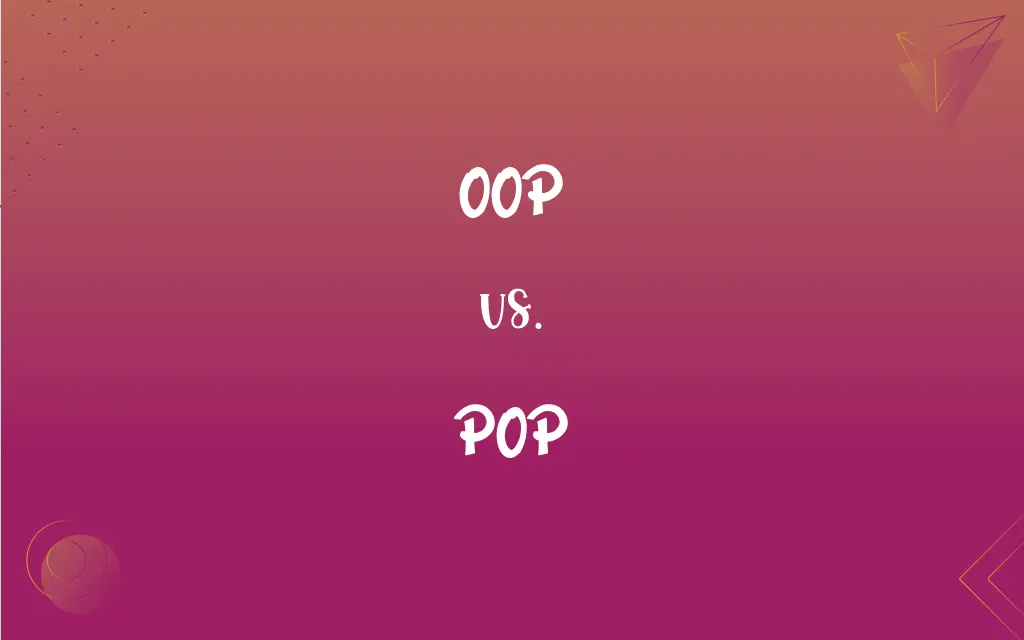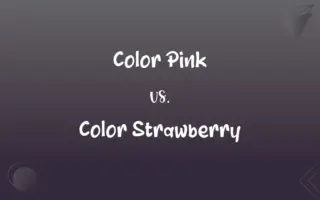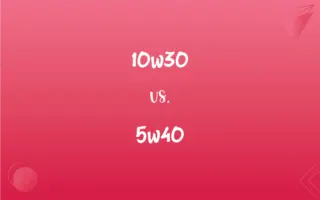OOP vs. POP: What's the Difference?
Edited by Aimie Carlson || By Janet White || Published on March 26, 2024
OOP (Object-Oriented Programming) structures code around objects, emphasizing modularity and reuse; POP (Procedure-Oriented Programming) structures code around functions, focusing on the sequence of actions.

Key Differences
OOP (Object-Oriented Programming) is a programming paradigm centered around objects created from classes, facilitating data encapsulation, abstraction, inheritance, and polymorphism. This approach promotes code reusability and modularity. In contrast, POP (Procedure-Oriented Programming) focuses on functions or procedures, emphasizing the sequence of actions to be executed. It's suitable for simple, linear task-oriented applications but lacks the flexibility and scalability of OOP.
In OOP, each object can carry data (attributes) and methods (functions) relevant to that data, which helps in simulating real-world scenarios and managing complex software architectures. POP, on the other hand, uses functions for task execution, where data is passed from one function to another, making it challenging to track and manage as applications grow.
OOP enhances code maintenance and readability by allowing changes in a single module to affect the whole application, through inheritance and polymorphism. This feature is absent in POP, where changes often require modifications across multiple functions, increasing the risk of errors.
OOP excels in scenarios requiring a high level of data security and abstraction, as it allows data hiding through access modifiers like private, protected, and public. However, POP offers limited data protection, as data is more exposed and can be easily manipulated by any part of the program.
Scalability in OOP is achieved through object reusability and inheritance, making it ideal for large, complex applications. Conversely, POP is less scalable due to its linear and function-focused approach, making it more suited for smaller, less complex programs.
ADVERTISEMENT
Comparison Chart
Programming Focus
Around objects and classes.
Around functions and procedures.
Code Structure
Modular, with encapsulation.
Linear, focusing on the sequence of actions.
Data Management
Data tied to objects, better security.
Data passed between functions, less secure.
Scalability
Highly scalable for complex systems.
Better for simple, linear tasks.
Maintenance & Reusability
Easier due to modularity.
More challenging, especially in larger systems.
ADVERTISEMENT
OOP and POP Definitions
OOP
Facilitates inheritance, allowing objects to inherit properties from other classes.
OOP allows a 'SportsCar' class to inherit from a general 'Car' class.
POP
Structures code as a sequence of operations or tasks.
A POP script may sequentially execute functions for user login, data processing, and logout.
OOP
Allows abstraction, hiding complex implementation details from the user.
OOP lets developers create complex applications with simple interfaces for users.
POP
POP focuses on writing procedures or functions that operate on data.
In POP, a program to calculate taxes would be a series of functions.
OOP
OOP organizes software design around data, or objects, rather than functions.
Java, a popular OOP language, uses classes to define objects.
POP
Suited for straightforward, linear programming tasks.
POP is ideal for small scripts where a complex architecture is unnecessary.
OOP
Emphasizes objects with encapsulated data and methods.
In OOP, a 'Car' object would have properties like speed and methods like accelerate.
POP
Emphasizes the step-by-step instructions to solve a task.
POP uses specific instructions in functions to perform calculations.
OOP
Supports polymorphism, enabling objects to be treated as instances of their parent class.
In OOP, a function designed for a 'Vehicle' class can also handle a 'Car' object.
POP
Lacks emphasis on data encapsulation and object-based division.
In POP, global data can be accessed and modified by any function.
OOP
(regional) up
POP
To make a short, sharp, explosive sound.
OOP
To bind with a thread or cord; to join; to unite.
FAQs
What is POP?
POP focuses on procedural or functional programming using functions.
How does OOP enhance code reuse?
OOP uses inheritance and polymorphism, allowing for code reuse.
What languages support OOP?
Java, C++, Python, and C# are examples of OOP languages.
What is OOP?
OOP is a programming paradigm centered around objects and classes.
Is POP suitable for large applications?
POP is less suitable due to its linear and less modular structure.
What are some examples of POP languages?
C and Fortran are traditional POP languages.
Can OOP be used for small projects?
Yes, but it might be an overkill for very simple tasks.
Are there performance differences between OOP and POP?
OOP can be slower due to abstraction, but it depends on the implementation.
Is POP good for beginners in programming?
Yes, its linear approach can be easier to understand initially.
What is polymorphism in OOP?
The ability of different objects to be treated as instances of the same class.
Is debugging easier in OOP or POP?
OOP’s modular design can make debugging more manageable.
How does inheritance work in OOP?
Child objects inherit properties and methods from parent classes.
Can POP handle complex user interfaces effectively?
It's less effective compared to OOP for complex interfaces.
How does POP handle data?
Data is passed between functions, often globally accessible.
Why is OOP popular in software development?
Due to its modularity, scalability, and maintainability.
Does POP emphasize code reusability?
Not as much as OOP, due to its focus on procedures.
Can OOP and POP be combined in a program?
Yes, many languages allow mixing both paradigms.
Is data security better in OOP?
Generally yes, due to encapsulation and data hiding features.
Are OOP languages more versatile than POP languages?
Typically, due to their features like abstraction and polymorphism.
Does POP support object-based data structuring?
No, it focuses on functions rather than objects.
About Author
Written by
Janet WhiteJanet White has been an esteemed writer and blogger for Difference Wiki. Holding a Master's degree in Science and Medical Journalism from the prestigious Boston University, she has consistently demonstrated her expertise and passion for her field. When she's not immersed in her work, Janet relishes her time exercising, delving into a good book, and cherishing moments with friends and family.
Edited by
Aimie CarlsonAimie Carlson, holding a master's degree in English literature, is a fervent English language enthusiast. She lends her writing talents to Difference Wiki, a prominent website that specializes in comparisons, offering readers insightful analyses that both captivate and inform.







































































